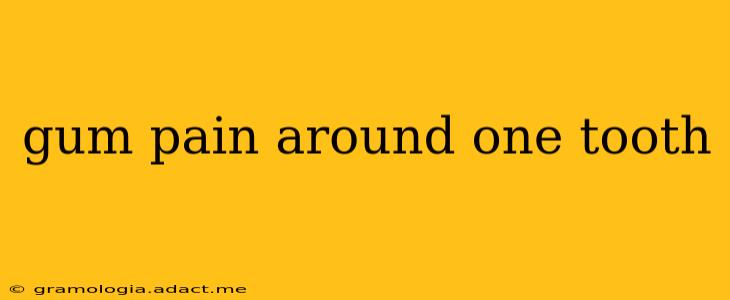Experiencing gum pain localized around a single tooth can be incredibly uncomfortable and disruptive. This localized pain often points to a specific dental issue, and understanding the potential causes is the first step towards effective treatment and prevention. This comprehensive guide explores common causes, effective treatments, and preventative measures to help you address this painful problem.
What Causes Gum Pain Around One Tooth?
Several factors can contribute to localized gum pain. Identifying the underlying cause is crucial for appropriate treatment. Here are some of the most common culprits:
-
Gingivitis: This is an early stage of gum disease characterized by inflammation and redness of the gums. While often affecting multiple teeth, it can present initially as pain concentrated around a single tooth, particularly one with plaque buildup.
-
Periodontitis: A more advanced form of gum disease, periodontitis involves the destruction of the tissues supporting the teeth. Localized pain can signal the onset of periodontitis, often accompanied by swelling, bleeding gums, and potential loosening of the affected tooth.
-
Abscess: A pus-filled pocket forming in the gum tissue around the tooth root is called an abscess. This infection causes intense, throbbing pain and requires immediate dental attention.
-
Dental Cavity (Caries): Although typically associated with toothache, a deep cavity can irritate the surrounding gum tissue, causing localized pain.
-
Trauma: Injury to the gum tissue, perhaps from biting down on a hard object or during dental procedures, can lead to pain and inflammation.
-
Impacted Tooth: A partially erupted tooth or an impacted wisdom tooth can irritate surrounding gum tissue, producing localized pain.
-
Food Impaction: A piece of food lodged between teeth can inflame the gums, leading to discomfort.
How Do I Know What's Causing My Gum Pain?
Self-diagnosing can be tricky, and it's essential to consult a dentist for a proper diagnosis. However, paying attention to accompanying symptoms can give you clues:
-
Swelling and Redness: These are classic signs of infection or inflammation, suggesting gingivitis, periodontitis, or an abscess.
-
Bleeding Gums: Bleeding gums while brushing or flossing often indicate gingivitis or periodontitis.
-
Sensitivity to Temperature: Sensitivity to hot or cold foods and drinks might suggest a cavity affecting the tooth's nerve or gum irritation.
-
Pus: The presence of pus points to an abscess, a serious infection requiring immediate dental care.
-
Loose Tooth: A loose tooth is a strong indication of advanced gum disease or trauma.
What Can I Do to Relieve Gum Pain Around One Tooth?
While home remedies can provide temporary relief, they are not a substitute for professional dental treatment. Here are some things you can try to ease discomfort:
-
Rinse with Salt Water: A warm saltwater rinse can help reduce inflammation and remove debris.
-
Over-the-Counter Pain Relievers: Ibuprofen or acetaminophen can help manage pain.
-
Gentle Brushing and Flossing: Use a soft-bristled toothbrush and floss gently to remove plaque and food particles. Avoid excessive force.
When Should I See a Dentist for Gum Pain?
It's crucial to schedule a dental appointment if you experience persistent gum pain, especially if accompanied by swelling, bleeding, pus, or a loose tooth. Don't delay seeking professional care, as untreated gum disease can lead to serious complications, including tooth loss.
How Can I Prevent Gum Pain?
Preventing gum pain involves diligent oral hygiene practices:
-
Brush and Floss Regularly: Brush your teeth twice daily with fluoride toothpaste and floss at least once a day.
-
Maintain a Healthy Diet: A balanced diet low in sugar contributes to oral health.
-
Regular Dental Checkups: Schedule regular checkups and professional cleanings to catch potential issues early.
-
Quit Smoking: Smoking significantly increases the risk of gum disease.
Can Gum Pain Around One Tooth Be a Sign of a Serious Problem?
Yes, persistent or severe gum pain, particularly when accompanied by other symptoms like swelling, pus, or fever, can be a sign of a serious infection like an abscess, which requires immediate medical attention. Advanced gum disease (periodontitis) can also lead to significant tooth loss if not addressed promptly.
What are the Long-Term Effects of Untreated Gum Pain?
Untreated gum pain and underlying conditions like gingivitis and periodontitis can lead to a range of serious consequences, including tooth loss, bone loss, and even systemic health problems, such as an increased risk of heart disease and diabetes. Therefore, addressing gum pain promptly is essential for long-term oral health.
Remember, this information is for educational purposes and doesn't replace professional dental advice. Always consult your dentist for diagnosis and treatment of gum pain. Early detection and intervention are key to preventing serious complications.
